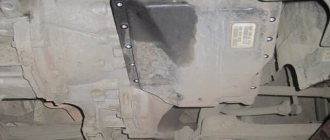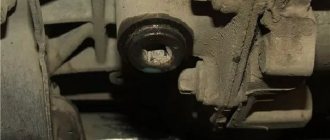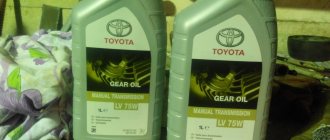The quality and sufficient quantity of lubricating fluid directly affects the performance of components and individual components of the car. Different car models require different volumes of lubricating fluid. And how much oil needs to be poured into the gearbox, and how often this is done, is regulated by the design features of the vehicle.
The type of lubricant will also be different for different machines. This depends on the age of the unit and its design. You should also follow the recommendations of the vehicle manufacturer.
This operation is most popular for classic VAZ models. After all, according to the recommendations of Tolyatti engineers, the replacement interval should be within 60-70 thousand kilometers. Although practice shows that it is preferable to do this about 10 thousand km earlier.
The intensive work of gears in a gearbox leads to their wear-out if the lubricant is not changed for a long time. This will be noticeable by metal shavings collecting on the magnetic cap, which is screwed in where the oil is poured into the gearbox.
Preparing the car for changing the gearbox oil
An oil change is required in the following cases:
- the color
of the oil has turned black or brown; - a burnt or scorched smell
; - level
has noticeably dropped below the minimum mark on the dipstick; - Grains
are clearly visible in the lubricant .
If the level is low, you can try topping it up, but more often than not, a complete replacement of the transmission fluid will help.
Selection of transmission oil
The main choice of oil is between the following types:
- mineral;
- semi-synthetic;
- synthetic.
Mineral oil
used on older vehicle models. Due to its low viscosity and fluidity, it holds well in boxes with significant wear and possible gaps in the body.
Semi-synthetic
has a lower viscosity and penetrates more easily into various areas of any gearbox. It usually contains chemical additives that increase corrosion resistance and protect against boiling or significant overheating.
Synthetic oil
is the most fluid due to its low viscosity. The molecules of this lubricant can quickly penetrate through various cracks, so in a gearbox with poor sealing properties, leaks and a decrease in its volume are possible.
Transmission oil
For those who are interested in how many liters of oil should be in the gearbox, we will give you an approximate formula. For “classics” you will need a volume of about 1.5 liters, and for cars of the “nine” or “tens” model range you will need to stock up on 3.5 liters.
Transmission oil volume
Every inexperienced driver faces the need to buy oil, because it is necessary for the smooth and high-quality operation of the engine. However, we should also not forget that oil must be poured not only into the engine, but also into the gearbox.
If you have been looking for information about changing the oil on the Internet, you may have probably noticed that there are advisors who do not consider it necessary to change the oil at all. It's a delusion.
Oil is necessary for smooth contact of parts and to prevent damage and abrasion. If its quantity is not enough, or it changes too rarely, this can lead to serious system breakdowns.
The volume of oil in the gearbox, which is necessary for its proper operation, is determined by the type of machine and the transmission itself. Typically, in technical documents for a vehicle, the manufacturer prescribes in detail the amount of oil that needs to be filled after a certain period of time.
Changing the gearbox oil
It will be easier to drain used lubricating fluid if its temperature is higher. To do this, you can drive several kilometers and return to the site of the operation. Next, we place the car either in a pit or on an overpass. After this, you need to turn off the engine and secure the car using the parking brake.
It is allowed to slightly jack up the car so that the tilt allows you to get rid of working as much as possible. After applying pressure, you can jack up the car on the other side.
Step 1. Open the filler hole Step 2. Check the oil level Step 3. Fill using a funnel Step 4. Add using a syringe
You can drain it after the oil reaches a temperature of about 40-45 C, so as not to get burned.
- We clean the area in which the filler hole is located and unscrew the screw plug.
- We place a sufficient container under the drain hole to remove waste. Wearing protective rubber gloves, unscrew the drain plug with a wrench. It is advisable to do this not with an open-end wrench, but with a socket head, so as not to damage the thread.
- We must wait until the maximum amount of fluid drains from the gearbox.
- It is necessary to remove possible particles of metal shavings from the magnetic plug.
- When waste practically stops coming out of the gearbox, you can screw the drain plug back into place.
- For “classic” VAZ models, we use a special syringe or a device made from a flexible hose and a watering can fixed at one of its ends. In other models, you can get by with a simple plastic watering can.
- We control the oil level using a dipstick or at the lower level of the inspection hole. Some drivers lift the car a little with a jack to add the “extra” 200-250 ml of oil.
- After this, you can tighten the filler hole.
You can find out a more accurate level after the car has driven several kilometers or been idling for 10-15 minutes. Then we turn off the car and after 5-7 minutes we measure the level with a dipstick. If necessary, add liquid. Excess can be drained through the appropriate hole.
Transmission oil is a fluid for lubricating the mechanical components of a car, namely the gearbox.
Various lubricants are necessary because they control the operation and ensure a long service life of the gearbox. A certain amount of them must be poured into the car. How many liters, ask. About three liters are poured into it. But remember that overfilling the liquid will result in the same destructive process for you as underfilling. Lubricants are:
- synthetic;
- semi-synthetic;
- mineral.
[Hide]
Fundamental differences between gearbox designs
An elementary fact that in the era of prosperity of electric vehicles will not surprise anyone: a modern car can be either manual or automatic.
But the banal understanding that an automatic transmission is an extremely complex mechanism, and therefore requires a more reverent attitude than a “handle”, actually already brings clarity to the subject of discussion. The physics of the lubrication system of two fundamentally different transmissions, a classic manual transmission and a hydromechanical automatic transmission, is not difficult to imagine. “Mechanics” is a primitive gearbox, the main condition for long-term and uninterrupted operation is the rotation of gears, shafts and bearings in an oil bath.
A hydromechanical “automatic” is a torque converter, a set of planetary gearboxes, a clutch pack, hydraulic control equipment and a control computer. Notice how loaded the mechanism is already from the set of words listed. The central focus is the hydraulic equipment, which painfully experiences deviations in the oil level from the norm, just like filling with low-quality lubricant. The problem is that insufficient lubricant pressure does not allow the clutch pack to be tightly compressed, causing the transmission to malfunction.
The variator and robotic gearbox are no less demanding on the pressure force in the hydraulic control system. After all, their design also includes friction clutches, albeit in smaller quantities. And in the case of a CVT transmission, the final point in the issue is its design tendency to overheat.
What oil should I use?
For such a car and its gearbox, it is better to use semi-synthetic oils. They are used for engines that make 3-4 thousand rpm. These are cheap foreign cars or domestically produced cars (such as the VAZ 2109). This type helps preserve gears and makes them more resistant to wear. This option is suitable for a gearbox and will preserve it for many years. But the main advantage of this type is good quality and affordable price. To do this, it must be replaced every 75,000 km.
Variety of gear oil on the counter
What kind of oil is better to fill in the VAZ-2110 gearbox
As you know, all oils can be divided into three types:
- Mineral.
- Synthetic.
- Semi-synthetic.
People who understand this issue are well aware that in practice, semi-synthetic oil has proven to perform much better than other types. And all because the performance properties of semi-synthetics are much better than those of mineral oil, and its price is more reasonable compared to synthetics. Among other things, it is semi-synthetic oil that is most suitable for use in temperate climates.
Transmission oil, the classification of which is GL-4, is suitable for use in VAZ cars equipped with front-wheel drive. One of these cars, in particular, is the 2110.
What is the volume in the box and how much should be poured?
As they wrote, a gearbox of this type will contain approximately three liters of transmission fluid. How much do you need to inject? It all depends on whether you are making a complete or partial replacement. It is recommended to do the full one. How much should I pour into the gearbox when it's full? Apply new lubricant in such an amount that it does not exceed o and does not underestimate o. The same rule applies to partial.
The gauge shows the maximum and minimum levels
- When you remove the dipstick from the hole, have a clean rag ready to wipe it off immediately.
- Before checking the level, warm up the car by shifting gears 1-2.
- Check the lubricant level before and after replacement.
- If your car doesn't have a dipstick, remember that the fluid should reach the bottom edge of the oil filler hole, but not below.
Pink dream of the 90s
The VAZ-21099 car still remains very popular not only in Russia, but also in almost all CIS countries. It is surprisingly repairable - you can handle most breakdowns yourself. One of the most common operations that have to be done is changing the oil and diagnosing the lubrication system of the engine and gearbox. Lubrication in a VAZ engine plays a very important role, so before each trip you should carefully inspect the car and its parking place. You will also need maximum attention if the oil pressure light suddenly blinks. This may indicate either a leak or a more serious breakdown.
Manual transmission: is oil overflow really dangerous?
What was your first car? With a high degree of probability, it can be argued that this was a copy of a Zhiguli product: a VAZ classic, something from the Samara family, an advanced “ten” or a Priora built on its basis. They all have one thing in common - manual transmission. And if we exclude the VAZ 2101-2107 models from this list, then collectively we can talk about the chronic tendency of the owners of other Ladas to pour oil into the gearbox.
Taking into account that the declared resource for such maintenance easily reaches 300,000 km, one gets the impression not of the harm of an overestimated level, but, on the contrary, of its benefit or, at least, a neutral effect. Indeed, in vaz clubs, exceeding the maximum is presented as improving the lubrication of the fifth gear needle bearings when it is engaged. At the same time, when the level is right at the MAX mark, oil starvation is observed, which explains the rapid failure of the “fifth”.
There are a lot of guesses why the maximum mark of the dipstick does not guarantee careful operation of the transmission in all modes. One of the versions is that oil, when the gears rotate, splashes on the walls, which is why the actual level is always lower than the calculated one.
The danger of oil overflow is also considered far-fetched from a design point of view. The axle seals, if we are talking about a front-wheel drive layout, will not be squeezed out, since a release valve (breather) is provided in the unit body. There is one more fact in favor of the “overflowers”: the breather can relieve not only pressure, but also lubricant. Therefore, excess oil always has a way out or, in popular parlance, the excess will be squeezed out, but the necessary will remain. The most you have to put up with is an oily outer casing and oil smudges on the engine protection and under the car. However, this is all temporary.
Changing the engine oil
Even if the car sits idle more than it drives, the oil in the VAZ engine should be changed twice a season. This is due to different viscosities of oils, which is especially important for regions with very harsh climates. For example, an oil with an index of 5W or even 0W will promote cold starting much better than 10W or 20W. Although if an injector is installed on a VAZ 21099, and the climate is more or less warm, then it is not necessary to change the oil twice a year. Another criterion for carrying out work is mileage. The oil should be changed once every 10-15 thousand km.
The procedure itself is extremely simple. Before replacing, you need to purchase 3.5 liters of new and flushing oil, and an oil filter. The car is driven onto a lift or pit. The engine must be well warmed up - otherwise the oil will not drain completely. Naturally, the VAZ engine turns off. Place the waste container, carefully unscrew the drain plug in the crankcase and the filler plug at the top of the engine. Allow all the oil to drain, being careful.
After the oil has drained, the drain plug is screwed in and flushing oil is poured in. The engine starts and should run for a few minutes. You cannot drive on flushing oil, especially if the car is a VAZ 21099 injector. Then the engine stops again, the oil is drained again, and the oil filter is unscrewed. Before installing a new oil filter, you must thoroughly lubricate its rubber gasket.
The plugs are screwed back in - job done!
Six-speed gearbox
If after replacement the oil pressure light begins to blink, then you need to tighten the oil filter a little and also inspect the engine for leaks. Perhaps one of the gaskets has started to corrode. This may also indicate that the oil pressure sensor has broken down or there is a more serious breakdown.
It is worth remembering that flushing the engine must be done only if oil of different viscosity or brand is poured. In other cases, flushing the engine is optional. It is advisable to combine such a procedure with such an important operation as replacing antifreeze. When all the fluids in the engine are new, the driver can be calm about the condition of his car.
When replacing fluids, you should not dump them on the ground - this can greatly harm the environment.
Changing the lubricant in the gearbox
Every 50-75 thousand km the oil in the VAZ gearbox needs to be changed. It can be done earlier, for example, when the transmission begins to hum and there is no way to repair it. If you add thicker oil, the hum will disappear for a while. As for how much oil needs to be filled, its volume for a standard gearbox is 3 liters. If the box is five-speed, then approximately 3.3 liters are needed. According to the instructions, the oil viscosity should be 80W-85.
There are two types of VAZ-21099 gearboxes. The first is old boxes without a probe. To change the oil in them you will need a special syringe. The second type includes modern models with a probe. With them, the whole procedure is no more complicated than replacing antifreeze.
This is how to change the lubricant in a gearbox
So, before work, it is necessary to clean the metal near the breather and filler neck as much as possible from dirt. Next, the rubber plug on the breather is removed, and the hole itself is cleaned with a clean wire or awl. After this, a container is placed, the drain bolt is unscrewed and the oil begins to flow out. Before the procedure, the probe must be pulled out and wiped. It is better to carry out the operation after a short trip, preferably in a warm box, so that the oil becomes as liquid as possible. After all the glass is filled, the plug is screwed in and new oil is poured in. In old boxes, the level is checked at the lower edge of the oil filler hole, in new ones - using a dipstick.
Of course, the operation takes more time than replacing antifreeze, but there is no need to check a large number of hoses and pipes. If after changing the oil the noise in the gearbox does not go away, then you will have to completely rebuild the gearbox. It is recommended to check the oil level again after a test drive.
The gearbox oil must be changed after long periods of inactivity. It is worth doing this even after purchasing the car, because it is not known what the previous owner poured into the transmission and whether he monitored the lubricant level.
The gears of any gearbox are subject to intense wear, so manual transmission lubrication can increase the service life and reduce maintenance costs. Transmission oils are classified by several specifications and do not have the same markings and composition, so the user must have at least minimal information about lubrication of a manual transmission.
How much oil to pour into the gearbox or the dangers of underfilling and overfilling
Each type of gearbox has its own oil requirement. Therefore, it is impossible to say that there is so much in the Ford Focus, and so much in the Toyota Camry. After all, the volume of oil depends on the specific box. Therefore, it is necessary to strictly follow the recommendations contained in the repair and maintenance manual for the machine. What are the dangers of underfilling and overfilling oil? If the oil level is below normal, then when operating at high speeds, lubrication and cooling of the rubbing parts worsens, which increases their wear. If the oil level is much lower than normal, then this process begins at medium and sometimes at low engine speeds. In this case, at high speeds, the parts come into contact with almost no lubrication, which is why their service life is sharply reduced.
If the oil level is higher than normal, then while the car is moving in gear, the pressure on the seals is higher than the calculated one and pushes them through. As a result, oil begins to leak out of the gearbox onto the ground. Over time, this process intensifies, which leads to a significant decrease in the oil level and damage to the box. This process takes place equally on both obsolete Soviet mechanics and modern hydraulic or robotic automatic transmissions. The only difference is the cost of parts and repairs. Therefore, the volume of oil being poured, as well as its level (this is especially important when partially changing the oil in automatic transmissions) must fully comply with those specified in the repair and operating instructions for the machine.
Purpose of gearbox lubrication
The gearbox is the largest gearbox in a car transmission. Thanks to a stepwise change in the gear ratio, the driver has the opportunity to combine two ranges - wheel speed in the range of 50 - 1500 min -1 and engine crankshaft speed 800 - 8000 min -1. Depending on the type of transmission, the gears of the gearbox are lubricated in the following ways:
- cylindrical - oil bath with immersion of low-speed wheels to a third of the diameter, high-speed wheels to a depth of h = 5m;
- bevel - crankcase lubrication with the entire lower tooth of the gear immersed in oil;
- planetary - the high-speed stage is immersed in an oil bath to the entire depth of the inner tooth.
The drain hole must have a diameter greater than 20 mm, and the slope of the crankcase bottom must be within 3 degrees. The filler plug is usually located at the level of the oil bath mirror, which makes it possible to do without a dipstick.
Information about what kind of oil to pour into a manual gearbox is relevant when repairing components and assemblies associated with the gearbox (for example, replacing the clutch) when the life of the lubricant itself is exhausted.
The gearbox traditionally belongs to units with high operating loads. In addition, passenger car manufacturers use different gear designs in different car models, so the frequency of oil changes in manual transmissions is required in the manual.
The user should note that changing the oil in a manual transmission has nuances:
- with a minimum maintenance budget (filling with mineral oil), operating costs will increase as the lubricant life will decrease;
- when purchasing expensive synthetics, on the contrary, the initial investment will increase, but the service life of such oil is longer and the replacement frequency is greater than in the previous case;
- Semi-synthetics have a rational ratio of lubricant quality and cost.
There are winter, all-season and summer oils that allow you to select a lubricant for different operating conditions.
Thus, oil in a manual transmission solves several problems simultaneously:
- lubrication and reduction of friction of gears;
- heat removal from friction pairs;
- removal of metal filings from the surfaces of wear parts of the gearbox;
- protection of gears and gears from oxidation and corrosion.
The cost of 3 liters of gear lubricant is significantly lower than replacing a manual transmission or breaking a gear while driving.
What kind of oil is poured into the gearbox?
In order to determine which oil to choose for your car, you should also look at the manual. The manufacturer indicates the desired oil parameters for each specific car. Choosing oil is a rather complex process with many nuances.
To select fluid for a manual transmission, you need to know:
- Firstly, automatic, manual and transfer transmissions will already require different types of fluid. They can be distinguished by the presence of corresponding letters on the packaging.
- In addition, it is necessary to pay attention to the viscosity level of the substance. It is divided into three groups depending on the time of year in which the oil is intended for use. It can be summer, winter and all-season. To find this indicator on the bottle you need to find two numbers (70, 85) and the letter W next to them.
- There is also a division for operating conditions. There are seven groups of oils in total, divided according to this criterion, but most often car enthusiasts use only two of them. If the car drives under normal conditions and with light loads, then you should choose oil of the fourth group. If the conditions are harsh and even extreme, you should pay attention to group number five. The marking on the bottle will look like GL with the group number. It is also worth considering that cars that drive on our Russian roads may well consider themselves to be overcoming extreme conditions. Winter lasts quite a long time, it is very dusty and windy outside, and the quality of gasoline often leaves much to be desired. Because of this, processes in the lubricant occur much faster, it quickly becomes unusable and requires replacement.
For automatic transmissions there are no specific rules for choosing oil according to criteria, since manufacturers have long established their standards. You can also find out what kind of oil is poured into the gearbox if you contact a service station.
Important! You should not fill oil of different classes in one tank or add new oil without pouring out the old oil. This can lead to serious transmission problems due to different fluid compositions. Only oils with the same characteristics can be mixed.
Manual transmission operating modes
Due to operating conditions, the car's gearbox must provide 1 - 2 lower gears, reverse speed and several higher gears. Large ratios (5/1 – 3.5/1) are used in lower gears. At the same time, the transmission of an SUV reaches a power range of 9 units, while in passenger cars it is limited to 6 units. The traction force in lower gears is maximum, but the car cannot reach high speed.
The gear ratios of the middle gears are in the range of 2.5/1 – 1.5/1. Engine noise is reduced at the same speeds. These gears are considered “short” and greatly tire the driver, as they require frequent switching in changing driving conditions.
Higher gears reach a gear ratio close to 1/1, that is, the shafts rotate at the same angular speeds. This is convenient on the highway when driving at a constantly high vehicle speed.
Classic gearboxes usually use 3 shafts - primary, intermediate and secondary. The gear units have helical gears to reduce noise. In addition to gears, the box contains synchronizers, cams and clutches.
For gearboxes with old-style synchronizers, budget manual gearbox oil marked GL-4 is used. For most modern cars, manufacturers specify hypoid oil GL-5.
Attention: An attempt to improve the quality of the lubricant in the gearbox of a domestic VAZ with high mileage will lead to the exact opposite effect - the operation of the synchronizers will be disrupted, since the films from these transmission lubricants have different properties.
The oil should be changed either at a service station, whose employees do not make such mistakes, or you should adhere to the requirements specified in the manual for operating the machine.
Transmission lubricant is considered a consumable material; after a certain mileage, its components begin to deteriorate, and metal shavings and foreign impurities accumulate inside, and the modifying additives decompose. That is why changing the oil in a manual transmission must be timely and technically competent.
Selecting a lubricant for a manual transmission
According to the international API system, developed by the American Petroleum Institute, manual transmission oil is marked with the letters GL. Of the six existing classes, only GL-3 and GL-4 modifications are used in manual transmissions. However, gearboxes with hypoid gears use GL-5 oil.
| Designation | Compound | Purpose |
| GL-1 | no extreme pressure additives, only base oil | transmissions without synchronizers |
| GL-2 | anti-wear modifiers | not suitable for gearboxes |
| GL-3 | 2.7% anti-wear additives | for MPP with spiral bevel gears |
| GL-4 | 4% extreme pressure modifiers | for manual transmission with synchronizers |
| GL-5 | 6.5 additives, including extreme pressure | for boxes without synchronizers |
| GL-6 | more than 7% sulfurphosphorus-containing additives | only for hypoid gears |
In the domestic GOST standard, transmission oils are designated TM. The marking uses two numbers separated by a hyphen:
- first – viscosity class;
- the second is a group for deciphering operational properties from the table below.
TM-3 – TM-5 is poured into mechanical boxes for temperature conditions within 150 degrees.
In addition, the gear lubricant has a viscosity classification according to SAE, developed by the American Society of Engineers. There are seven classes in the SAE system:
- four winter ones marked W;
- three summer ones without markings;
- several all-season with double markings.
For example, multi-grade gear oil for manual transmissions marked 75W90 simultaneously has the characteristics of a 75W winter gear lubricant and a 90 summer gear lubricant.
Leading gearbox manufacturers General Motors and Ford have additionally developed their own designations for automatic transmission lubricants. The ZF company produces lubricants marked TE-ML 1 and TE-ML 2 for passenger cars and SUVs with manual transmissions.
Despite the fact that GL-5 lubricant has better characteristics compared to GL-4 oil, it is not suitable for manual transmissions with synchronizers for a number of reasons:
- there are more sulfur-phosphorus additives here - 6.5% instead of 4%;
- synchronizers are made of copper-containing alloys;
- in the presence of sulfur, these alloys corrode.
In front-wheel drive cars, the main gear is located inside the gearbox, so the designers had to choose between scuffing the main gears and corrosion of the synchronizers, so in the manuals of cars from French manufacturers, GL-5 oil is poured into the manual transmission, while others consider the best option to be all GL-4.
Attention: Synthetic oil usually has a dual API specification, so it can be used in transmission gearboxes without the above selection problems.
Frequency of lubricant replacement
Unlike the engine, the gearbox is located in a hard-to-reach place on the car, so daily monitoring of the level and color of the lubricant is impossible - no one will remove the wheel before every trip, so information on whether the oil needs to be changed should be based on the following factors:
- for manual transmissions, an operating interval of 7 years or a mileage of 100,000 km is accepted (depending on what comes first);
- for the urban cycle it is recommended to reduce these figures by 30%;
- the specified regulation - 70,000 km or 6.5 years of operation - is valid only for synthetic oil with a maximum service life;
- when using semi-synthetics, you should change the oil in the manual transmission more often - after 50,000 km;
- Mineral lubricant must be changed every 40,000 km of vehicle mileage.
Attention: When purchasing a new domestic passenger car, information on how to change the oil in the gearbox is relevant on the same day. Since the VAZ comes off the assembly line with mineral oil, which is better to change to semi-synthetic oil immediately.
Replacement intervals - when to change the oil?
When to change the gearbox oil is the subject of debate on numerous forums. Some argue that the gearbox oil needs to be changed every 50 thousand kilometers, others say that every 100-200 thousand, and still others refer to the manual for some cars, where it is written that the oil is filled for the entire service life and does not require replacement . Manufacturers are interested in ensuring that the machine lasts the warranty period and becomes in such a condition that it would have to be repaired or replaced. Those who change oil every 200 thousand kilometers assume that the car will survive one oil change, but let the new owner think about another.
Lubricant level diagnostics
Due to the use of different gears (planetary, cylindrical, bevel), the oil level in the manual transmission is different.
Transmission manufacturers have made it easier for users to check the oil level:
- either a dipstick is built into the filler plug, or the neck is located at the level of the oil mirror;
- the drain plug is equipped with a magnet that collects metal shavings;
- the bottom of the crankcase has a slope towards the drain hole, but the car must be horizontal, and the lubricant flows through the funnel.
Having decided which oil to pour based on viscosity and operating temperature, you can change the lubricant in the garage yourself. The operating manual indicates the amount of oil. The algorithm for checking the lubricant level in the gearbox is extremely simple:
- the engine must be warmed up and then cooled down within 3 hours after the trip;
- install the machine horizontally;
- clean the gearbox housing near the filler plug and unscrew it with a wrench.
The norm is the level along the lower edge of the filler hole; in all other cases, the user pours it in until the lubricant begins to pour back out.
Note: how to check the oil level on an automatic transmission
So, both low and high volumes of lubricant are dangerous for an automatic machine. To correctly calculate the actual level, the automatic transmission must be warmed up and the engine must be left running. I outlined these nuances and more in the technology for measuring the amount of oil in a classic “automatic machine”:
- Heat the transmission fluid to operating temperature. Drive 10-20 km in “road” mode, then let the engine run at idle for 5 minutes. Without stopping the engine, operate the automatic transmission selector in place, moving it through all positions with a delay of 2-3 seconds.
- Move the selector to position P. The engine is still running.
- Remove the dipstick, wipe it, insert it all the way and pull it out again. Based on the position of the liquid trace relative to the notches, the oil level inside the unit is judged. The norm is considered to be +2-3 mm above the minimum mark next to the HOT inscription.
And don’t forget - measuring the level of any technical fluid is carried out on a strictly horizontal platform.
Changing the oil in a manual transmission
After a run of 30 – 70 thousand kilometers, when the oil should be changed according to the manufacturer’s recommendations, you need to buy lubricant in the required quantity and stock up on a container for draining the waste. The main nuances are:
- The oil in a manual transmission should be changed on a warm engine in order to increase the rate of fuel flow out of the drain neck;
- the best oil, diluted with some amount of lubricant remaining inside the crankcase, will last significantly less because it will lose its declared characteristics;
- to access the drain hole, the front wheel on the driver's side is usually removed and the car is hung on a jack;
- Knowing approximately how much oil the manufacturers poured, you can avoid overfilling.
By replacing the used working medium with good oil, gear shifting will improve and extraneous noise will disappear.










